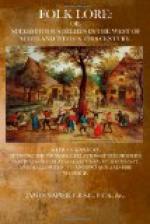The Onion was regarded as a symbol of the universe among the ancient Egyptians, and many curious beliefs were associated with it. It was believed by them that it attracted and absorbed infectious matters, and was usually hung up in rooms to prevent maladies. This belief in the absorptive virtue of the onion is prevalent even at the present day. When a youth, I remember the following story being told, and implicitly believed by all. There was once a certain king or nobleman who was in want of a physician, and two celebrated doctors applied. As both could not obtain the situation, they agreed among themselves that the one was to try to poison the other, and he who succeeded in overcoming the poison would thus be left free to fill the situation. They drew lots as to who should first take the poison. The first dose given was a stewed toad, but the party who took it immediately applied a poultice of peeled onions over his stomach, and thus abstracted all the poison of the toad. Two days after, the other doctor was given the onions to eat. He ate them, and died. It was generally believed that a poultice of peeled onions laid on the stomach, or underneath the armpits, would cure any one who had taken poison. My mother would never use onions which had lain for any length of time with their skins off.
So lately as 1849, Mr. J.B. Wolff, in the Scientific American, states that he had charge of one hundred men on shipboard, cholera raging among them; they had onions on board, which a number of the men freely ate, and these were soon attacked by the cholera and nearly all died. As soon as this discovery was made, the eating of the onions was forbidden. Mr. Wolff came to the conclusion that onions should never be eaten during an epidemic; he remarks, “After many years experience, I have found that onions placed in a room where there is small-pox, will blister and decompose with great rapidity,—not only so, but will prevent the spread of disease;” and he thinks that, as a disinfectant, they have no equal, only keep them out of the stomach.




